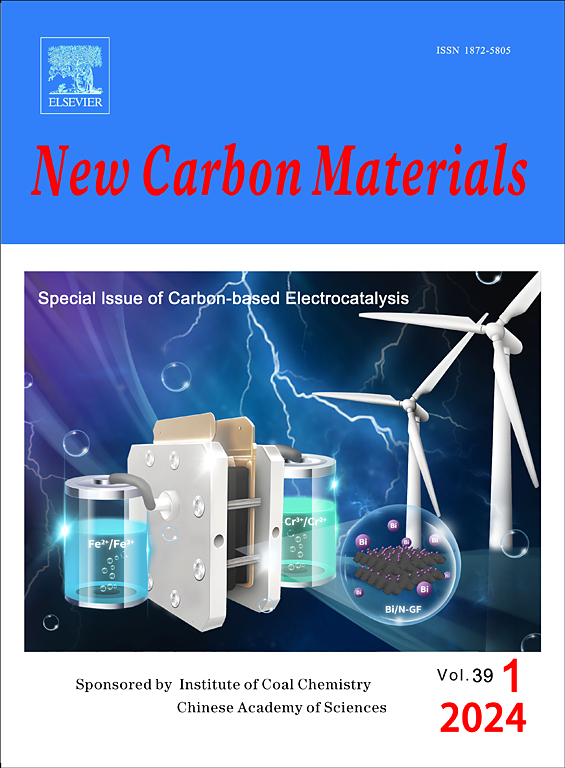A review of carbon-based hybrid materials for supercapacitors
IF 5.7
3区 材料科学
Q2 Materials Science
引用次数: 0
Abstract
Supercapacitors are gaining popularity due to their high cycling stability, power density, and fast charge and discharge rates. Researchers are exploring electrode materials, electrolytes, and separators for cost-effective energy storage systems. Advances in materials science have led to the development of hybrid nanomaterials, such as combining filamentous carbon forms with inorganic nanoparticles, to create new charge and energy transfer processes. Notable materials for electrochemical energy-storage applications include MXenes, 2D transition metal carbides, and nitrides, carbon black, carbon aerogels, activated carbon, carbon nanotubes, conducting polymers, carbon fibers, and nanofibers, and graphene, because of their thermal, electrical, and mechanical properties. Carbon materials mixed with conducting polymers, ceramics, metal oxides, transition metal oxides, metal hydroxides, transition metal sulfides, transition metal dichalcogenide, metal sulfides, carbides, nitrides, and biomass materials have received widespread attention due to their remarkable performance, eco-friendliness, cost-effectiveness, and renewability. This article explores the development of carbon-based hybrid materials for future supercapacitors, including electric double-layer capacitors, pseudocapacitors, and hybrid supercapacitors. It investigates the difficulties that influence structural design, manufacturing (electrospinning, hydrothermal/ solvothermal, template-assisted synthesis, electrodeposition, electrospray, 3D printing) techniques and the latest carbon-based hybrid materials research offer practical solutions for producing high-performance, next-generation supercapacitors.
- Download: Download high-res image (158KB)
- Download: Download full-size image
超级电容器用碳基混合材料综述
超级电容器由于其高循环稳定性,功率密度和快速充放电速率而越来越受欢迎。研究人员正在探索具有成本效益的储能系统的电极材料、电解质和分离器。材料科学的进步导致了混合纳米材料的发展,例如将丝状碳形式与无机纳米颗粒相结合,以创造新的电荷和能量转移过程。电化学储能应用中值得注意的材料包括MXenes、二维过渡金属碳化物和氮化物、炭黑、碳气凝胶、活性炭、碳纳米管、导电聚合物、碳纤维和纳米纤维以及石墨烯,因为它们具有热、电和机械性能。与导电聚合物、陶瓷、金属氧化物、过渡金属氧化物、金属氢氧化物、过渡金属硫化物、过渡金属二硫化物、金属硫化物、碳化物、氮化物和生物质材料混合的碳材料因其优异的性能、生态友好性、成本效益和可再生性而受到广泛关注。本文探讨了用于未来超级电容器的碳基杂化材料的发展,包括双层电电容器、伪电容器和杂化超级电容器。它研究了影响结构设计、制造(静电纺丝、水热/溶剂热、模板辅助合成、电沉积、电喷涂、3D打印)技术的困难,以及最新的碳基混合材料研究,为生产高性能、下一代超级电容器提供了实用的解决方案。下载:下载高分辨率图片(158KB)下载:下载全尺寸图片
本文章由计算机程序翻译,如有差异,请以英文原文为准。
求助全文
约1分钟内获得全文
求助全文
来源期刊

New Carbon Materials
MATERIALS SCIENCE, MULTIDISCIPLINARY-
CiteScore
6.10
自引率
8.80%
发文量
3245
审稿时长
5.5 months
期刊介绍:
New Carbon Materials is a scholarly journal that publishes original research papers focusing on the physics, chemistry, and technology of organic substances that serve as precursors for creating carbonaceous solids with aromatic or tetrahedral bonding. The scope of materials covered by the journal extends from diamond and graphite to a variety of forms including chars, semicokes, mesophase substances, carbons, carbon fibers, carbynes, fullerenes, and carbon nanotubes. The journal's objective is to showcase the latest research findings and advancements in the areas of formation, structure, properties, behaviors, and technological applications of carbon materials. Additionally, the journal includes papers on the secondary production of new carbon and composite materials, such as carbon-carbon composites, derived from the aforementioned carbons. Research papers on organic substances will be considered for publication only if they have a direct relevance to the resulting carbon materials.
 求助内容:
求助内容: 应助结果提醒方式:
应助结果提醒方式:


